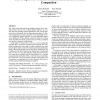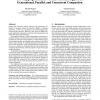1024 search results - page 62 / 205 » Complexity and Performance in Parallel Programming Languages |
146
click to vote
ASPLOS
2009
ACM
15 years 7 months ago
2009
ACM
The growth in complexity of modern systems makes it increasingly difficult to extract high-performance. The software stacks for such systems typically consist of multiple layers a...
PLDI
2006
ACM
15 years 1 months ago
2006
ACM
The widely used Mark-and-Sweep garbage collector has a drawback in that it does not move objects during collection. As a result, large long-running realistic applications, such as...
HPCC
2007
Springer
15 years 1 months ago
2007
Springer
One of the outcomes of DARPA’s HPCS program has been the creation of three new high productivity languages: Chapel, Fortress, and X10. While these languages have introduced impro...
ASPLOS
2008
ACM
14 years 9 months ago
2008
ACM
Parallel and concurrent garbage collectors are increasingly employed by managed runtime environments (MREs) to maintain scalability, as multi-core architectures and multi-threaded...
APPINF
2003
14 years 8 months ago
2003
Whenever large homogeneous data structures need to be processed in a non-trivial way, e.g. in computational sciences, image processing, or system simulation, high-level array prog...


